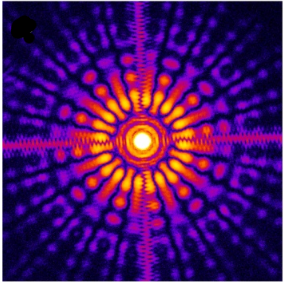X-ray generation and lens-less imaging
These projects are a collaboration between our group and dr. Stefan
Witte from the EUV Generation and Imaging group at ARCNL, and was originally funded by a
NWO-Groot grant. It is now partially funded by ARCNL and a Vidi and ERC grant of S. Witte.

|
HHG facility
A laser facility was constructed as part of an NWO-Groot project to
develop a coherent X-ray source based on high-harmonic
generation (HHG) from high-power laser pulses. The idea is to enable
imaging potentially with a resolution as high as 10 nm of biological or solid-state systems using light
with a wavelength between 10-100 nm.
The laser system for creating the HHG radiation is a 0.25 TW, 20 fs parametric amplifier laser system running at 300 Hz.
Parametric amplification allows to generate high-power laser pulses
over a wide range of wavelengths, which in turn determines the
wavelengths generated by the HHG process. Interestingly, the longer the
'driving' wavelength, the shorter the wavelength of the generated
harmonics that can be generated.
We
published a paper about the 300 Hz Nd:YAG based pump
laser (see below), and we have constructed the parametric
amplifier that is pumped by this system. It is now used to produce
high-harmonics with 20 fs pulses (with a potential for 10 fs with
better compression in the future), and depending on the type of
experiment we have a pulse energy of 0.5 to ~5 mJ available.
Paper on the pump laser for this system:
D.W.E. Noom, S. Witte, J. Morgenweg, R. Altmann, K.S.E. Eikema,
High energy, high repetition rate picosecond pulses from a quasi-CW diode pumped Nd:YAG system
Optics Letters 38, 3021-3023 (2013)
|
|
Lens-less imaging from NIR to XUV wavelengths
Imaging
with XUV or X-rays is a complicated task. Almost no normal optics exist for
such short wavelengths (in our case the target is 10-100 nm). Fresnel zone plates could
be used, but are difficult to make and certainly not ideal for broad
bandwidth sources such as the X-ray source based on high-harmonic
generation that is now under construction in our lab. Other forms of
imaging such as holography also require a relatively narrow bandwidth
source. A reduction in bandwidth through a monochromator is very lossy
at X-ray wavelengths and leads to very low efficiency.
For this reason we have developped new methods of lens-less imaging
based on diffraction, that also work for broad-bandwidth light sources.
Based on diffraction of two broadband laser pulses, we have shown
that fast image reconstruction is possible over a
wide field of view using all the wavelengths within the pulse
spectrum. Combined with high-harmonic generation we could also show
that it even works at extreme ultraviolet wavelengths near 50 nm. We
are now working on extending this method to shorter wavelengths.
By using a combination of 4 birefringent prisms we were able to make
ultra-stable (0.8 attosecond rms stability) pulse pairs, and performed
spatially resolved Fourier-Transform spectroscopy in the XUV, which was
published recently in Optica:
G.S.M. Jansen, D. Rudolf, L. Freissem, K.S.E. Eikema, and S. Witte,
Spatially resolved Fourier-transform Spectroscopy in the extreme ultraviolet
Optica 3, 1122 (2016)
https://www.osapublishing.org/optica/abstract.cfm?uri=optica-3-10-1122&origin=search
A paper about the two-pulse diffractive lensless imaging method was published here:
S. Witte, V.T. Tenner, D.W.E. Noom and K.S.E. Eikema
Lenssless diffractive imaging with ultra-broadband table-top sources: from infrared to extreme ultraviolet wavelengths
Light: Science and Applications 3, 1-7 (2014) (open access)
Moreover, we also demonstrated a lensless microcope using 3 different laser diodes:
D.W.E. Noom, K.S.E. Eikema and S.Witte
Lensless phase contrast microscopy based on multi-wavelength Fresnel diffraction
Optics Letters 39, 193–196 (2014)
|
 |
|
We gratefully acknowledge financial support from:
Questions? Contact: k.s.e.eikema@vu.nl
|






